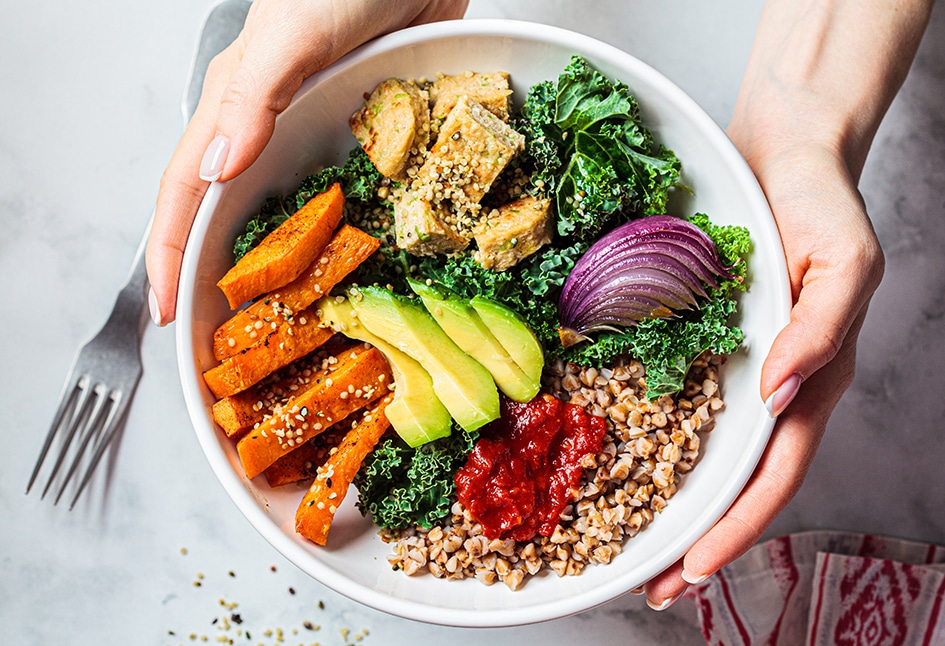
Diabetes is a widespread disease in the United States these days, and it’s only getting more prevalent as time goes on. Centers for Disease Control and Prevention data suggests that 37.3 million people have diabetes in the United States alone. That’s equivalent to 11.3 percent of the country’s population.
Since diabetes is an incurable condition, knowing how to manage it is crucial. A big part of this process is eating a healthy diet—and switching to a plant-based diet can be an excellent choice for many people living with diabetes. But if you aren’t already following one of these diets, you may have questions like:
- What is a plant-based diet, exactly?
- Why is a plant-based diet good for people living with diabetes?
- How do plant-based diets help reduce my chances of diabetes?
- How can plant-based diets affect type 2 diabetes?
If you’re looking for answers to these plant-based diet questions and more, read on for ADS’ complete guide on how to start a plant-based diet for diabetes.
Why a Plant-Based Diet is Good for Managing Diabetes
If you’ve just been diagnosed with diabetes, you’ll need to make some dietary changes. But that comes with a silver lining of sorts—if you’ve been thinking about trying a plant-based diet, this is a perfect opportunity to do so. But before you do, it’s wise to read up on what this diet is and how it can help you control this condition. 
What is a Plant-Based Diet and How Does it Work for Diabetes?
Confusingly enough, there’s no concrete definition of the term “plant-based diet.” Instead, this phrase can refer to any diet which prioritizes plant consumption.
Naturally, vegetarianism fits neatly into the category of plant-based diets for diabetics. The three basic vegetarian diets to understand are:
- Vegan diets, which are purely plant-based and include zero animal products
- Lacto-vegetarian diets, which are similar to vegan diets but add dairy products
- Lacto-ovo vegetarian diets, which allow for the consumption of eggs and dairy
Any one of these diets can be considered “plant-based,” but diets in this category aren’t limited to these three options. You can still eat a plant-based diet if you consciously restrict your intake of meat, poultry, and seafood—even if you don’t eliminate these foods from your life.
Are you still wondering, “is a plant-based diet good for people living with diabetes?” If you’re putting together a diabetes meal plan, you’ll note that these diets emphasize fresh fruits and vegetables, lean proteins, and whole grains. At the same time, they minimize unhealthy fats and sodium. While a successful diabetes diet doesn’t have to be plant-based, many plant-based diets share these priorities—and that’s why eating a plant-based diet is a natural fit for many people with diabetes.
How Can a Plant-Based Diet Help Reduce the Chances of Diabetes?
While plant-based diets can provide significant help with diabetes control, that isn’t the only benefit they offer. These diets can actively lower people’s chances of developing diabetes in the first place.
According to a 2021 article published in Advances in Nutrition, current scientific evidence strongly suggests vegan and vegetarian diets can lower people’s risk of type 2 diabetes. One study cited by the article, which included over 60,000 participants, determined that the prevalence of diabetes among vegans was 49 percent lower than that of non-vegetarians after BMI adjustments and other lifestyle factors. (Meanwhile, the prevalence of diabetes among lacto-ovo vegetarians was 46 percent lower.) The vegan participants consumed 33% more fruits and vegetables than the nonvegetarians and avoided animal products that are high in saturated fat and are associated with insulin resistance.
The Benefits of a Plant-Based Diet For People Living With Diabetes
If you already have diabetes, following a plant-based diet won’t reverse this condition. However, these diets can help you control your diabetes more effectively than ever by making it easier to:
- Lose weight. Weight loss is one of the most effective ways to manage diabetes. By following a plant-based diet focusing on whole foods, you can lose weight while staying healthy. The biggest reason why: these diets tend to include fewer calories while delivering all the nutrients you need and make you full faster and longer.
- Control your blood sugar. As you might expect, vegetarian and vegan diets are all about fresh produce, nuts, and legumes. All of these foods can assist with blood sugar control and improve your ability to respond to insulin. (To fully enjoy this benefit, you’ll need to limit your intake of simple carbs—even if they’re considered vegetarian.)
- Reduce your cardiovascular disease risk. Cardiovascular disease is an all-too-common complication of diabetes. Fortunately, vegan and vegetarian diets are ideal for lowering your odds of cardiovascular disease. These diets are typically low in cholesterol and saturated fat while boasting high levels of soluble fiber.
Plant-Based Meal Tips for a Healthier Lifestyle
If you’re switching to a plant-based diet, you might need some ideas for meals, snacks, and desserts to add to your regular rotation. Below are a few plant-based diabetic meal ideas to keep in mind while building your vegan or vegetarian diet.
Delicious and Nutritious Plant-Based Meals
Whether you have diabetes or not, breakfast is the most important meal of the day. You can start the day off right with ideas like fruit and vegetable protein smoothies, oatmeal with flaxseed or nuts, vegetable hash, whole grain waffles, tofu scrambles, dairy free yogurt parfaits, nut butters, fresh fruit and/or avocado on whole grain toast.

For lunch or dinner try bean and vegetables with a whole grain or low carb tortilla, couscous salad, Mediterranean Chickpea salad, hummus and veggie sandwich, tofu and veggie stir-fry with brown rice, whole grain pasta with vegetables, a veggie burger with kale salad, bean chili, or lentil salad to name a few.
Snacks For a Plant-Based Diabetic Meal Plan
If you eat moderate portions of the right snacks, these can still be part of your plant-based diet for people living with diabetes. Meanwhile, carb-counting and access to the right recipes will even allow you to continue enjoying snacks. Ideas include fresh fruit or unsweetened packaged fruit (applesauce, fruit cups), nuts, or seeds, nut butter on whole grain crackers, vegetables (cauliflower, baby carrots bell peppers, radishes, broccoli, snap peas, celery) or pretzels with hummus. Edamame, air-popped popcorn, a whole grain English muffin topped with avocado, and tomato are all excellent plant-based snack ideas or even dessert options.
How to Start a Plant-Based Diet
By now, you know why plant-based diets are such a good fit for people with diabetes and what recipes you can include in these diets. The final step, of course, is starting your own plant-based diet. This is easier said than done, but remembering a few pieces of advice can help.
Tips for Transitioning to a Plant-Based Diet for Diabetes Management
When you’re working to start a plant-based diet:
- Have a specific diet in mind. Plant-based diets mean different things to different people, so it pays to know which diets in this category fit your lifestyle. Your plant-based diet could cut out all animal products, allow for dairy and eggs, or even include small amounts of meat or fish.
- Decide what transition style is right for you. Going plant-based doesn’t have to mean going cold turkey. Depending on your own preferences, you can ease into your new meal plan and not abruptly switch your eating habits.
- Keep the plant-based food groups in mind. The five food groups that act as the “bedrock” of any plant-based diet are fruits, vegetables, tubers (root vegetables), whole grains, and legumes. Make sure to eat reasonable portions of foods that fall into each of these groups.
Overcoming Challenges and Sticking to a Plant-Based Diabetic Meal Plan
Following the above tips can help you jump into a plant-based diet, but making a lifestyle change of this magnitude takes some work. For example, you might need help with:
- Motivation. Any new diet can be hard to stick to, and plant-based diets are no exception. Attending a diabetes support group and letting people know about this change is a great way to hold yourself accountable—and get good advice for your new diabetes meal plan.
- Protein consumption. For many people, meat is a vital source of protein. Still, you won’t necessarily have trouble getting protein on a plant-based diet—you’ll just need to think a bit more about this. Popular plant-based protein options include tofu, nuts, seeds, and legumes.
- Dealing with other parts of your life. Unfortunately, you can’t put real life on pause while you start your plant-based diet for diabetes. One great way to deal with this issue is to simplify the rest of your diabetes management strategy in the meantime. For example, you can get diabetes supplies sent directly to your home with great turnaround times and exceptional customer service by ordering them from ADS!
